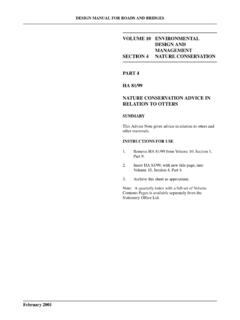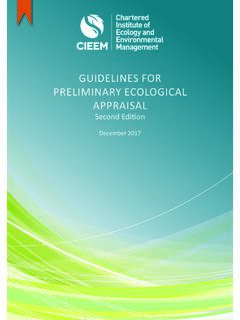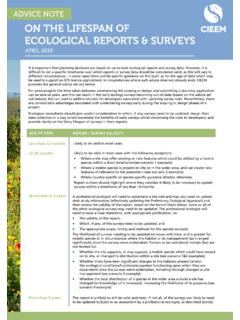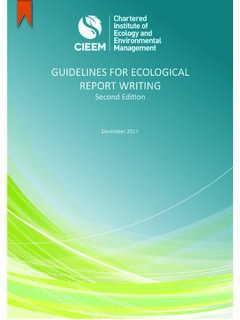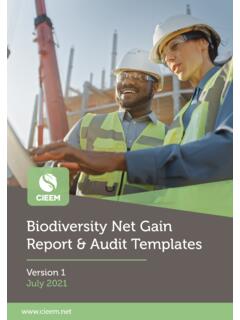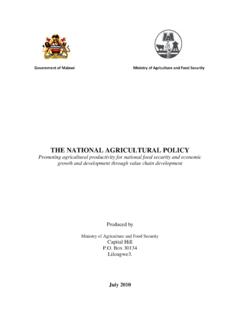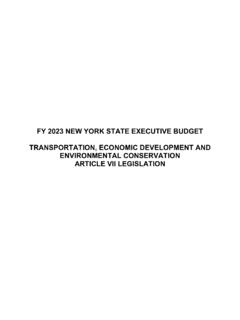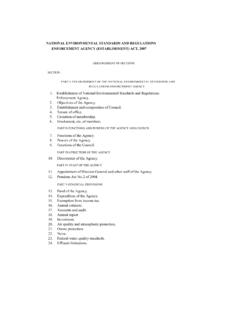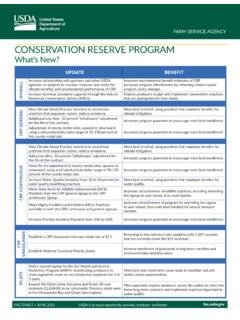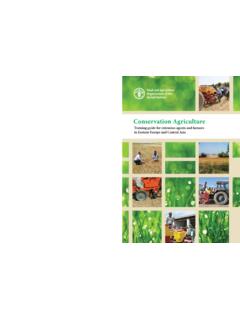Transcription of Biodiversity Net Gain
1 Biodiversity Net GainGood practice principles for developmentContentsIntroduction 1 Achieving Biodiversity Net gain Establishing good practiceSupporting guidanceBiodiversity Net gain - Good practice principles for development 2 Principle 1. Apply the Mitigation HierarchyPrinciple 2. Avoid losing Biodiversity that cannot be offset by gains elsewherePrinciple 3. Be inclusive and equitablePrinciple 4. Address risksPrinciple 5. Make a measurable Net gain contributionPrinciple 6. Achieve the best outcomes for biodiversityPrinciple 7. Be additionalPrinciple 8. Create a Net gain legacy Principle 9. Optimise sustainability Principle 10. Be transparent Acknowledgements 4 Supporting guidance How you can get involvedBiodiversity Net gain : Good practice principles for development CIEEM, CIRIA, IEMA, 20161 Achieving Biodiversity Net GainDesigning, building, operating and maintaining - each of these stages of a development scheme generates opportunities to help achieve an overall benefit for Biodiversity .
2 Realising these opportunities is vital because Biodiversity , and the functions it provides, are essential to sustain our society and these net gains in Biodiversity , where there are wider benefits for society, is more than simply outweighing losses with gains. It requires doing everything possible to avoid losing Biodiversity in the first place, as well as involving stakeholders especially as partners. It also requires the gains in Biodiversity to be valuable locally, and to make important contributions towards regional and national priorities for nature conservation . In other words, there is a right way to achieve Biodiversity Net gain that brings about long-lasting and meaningful benefits for our environment, society and right way is articulated in standards and guidelines produced by an international community on achieving No Net Loss and Net gain targets for Biodiversity . In the United Kingdom, the government has international and national commitments on Biodiversity that include halting the loss of Biodiversity and reaching net gains.
3 Development can contribute significantly towards realising these commitments. However, until now there has been no standard for the UK industry on good practice for achieving Biodiversity Net gain . Establishing good practiceCIRIA, CIEEM and IEMA have developed the first UK principles on good practice to achieve Biodiversity Net gain . These principles provide a framework that helps improve the UK s Biodiversity by contributing towards strategic priorities to conserve and enhance nature while progressing with sustainable development. They also provide a way for industry to show that projects followed good is important that these principles are tested, refined and improved through feedback and review. CIRIA, CIEEM and IEMA will undertake a first review within 12 guidanceThe principles are broad by necessity so that they apply to a wide-ranging industry. This means that their proper interpretation is critical. CIRIA, CIEEM and IEMA are developing guidance that will contain practical advice on implementing the Net gain principles and definitions of key terms.
4 This guidance will be available in 2017, and a steering group will be overseeing its production and consultation with a variety of of that stakeholder consultation is discussing a credible, proportionate way to audit implementation of Biodiversity Net gain . While this is in progress, developments claiming to achieve Biodiversity Net gain must provide evidence that clearly demonstrates they have implemented and adhered to the good practice principles. Introduction2 Biodiversity Net gain is development that leaves Biodiversity in a better state than before. It is also an approach where developers work with local governments, wildlife groups, land owners and other stakeholders in order to support their priorities for nature conservation . These ten principles set out good practice for achieving Biodiversity Net gain and must be applied all together, as one 1. Apply the Mitigation Hierarchy Do everything possible to first avoid and then minimise impacts on Biodiversity .
5 Only as a last resort, and in agreement with external decision-makers where possible, compensate for losses that cannot be avoided. If compensating for losses within the development footprint is not possible or does not generate the most benefits for nature conservation , then offset Biodiversity losses by gains 2. Avoid losing Biodiversity that cannot be offset by gains elsewhereAvoid impacts on irreplaceable Biodiversity - these impacts cannot be offset to achieve No Net Loss or Net gain . Principle 3. Be inclusive and equitable Engage stakeholders early, and involve them in designing, implementing, monitoring and evaluating the approach to Net gain . Achieve Net gain in partnership with stakeholders where possible, and share the benefits fairly among 4. Address risks Mitigate difficulty, uncertainty and other risks to achieving Net gain . Apply well-accepted ways to add contingency when calculating Biodiversity losses and gains in order to account for any remaining risks, as well as to compensate for the time between the losses occurring and the gains being fully 5.
6 Make a measurable Net gain contributionAchieve a measurable, overall gain1 for Biodiversity and the services ecosystems provide while directly contributing towards nature conservation priorities. Biodiversity Net GainGood practice principles for development1 Net gain has been described as a measurable target for development projects where impacts on Biodiversity are outweighed by a clear mitigation hierarchy approach to first avoid and then minimise impacts, including through restoration and / or compensation. Adhering to these Net gain principles ( pursuing all principles together) will help in under-pinning good practice for achieving and sustaining Net 6. Achieve the best outcomes for Biodiversity Achieve the best outcomes for Biodiversity by using robust, credible evidence and local knowledge to make clearly-justified choices when: Delivering compensation that is ecologically equivalent in type, amount and condition, and that accounts for the location and timing of Biodiversity losses Compensating for losses of one type of Biodiversity by providing a different type that delivers greater benefits for nature conservation Achieving Net gain locally to the development while also contributing towards nature conservation priorities at local, regional and national levels Enhancing existing or creating new habitat Enhancing ecological connectivity by creating more, bigger, better and joined areas for biodiversityPrinciple 7.
7 Be additionalAchieve nature conservation outcomes that demonstrably exceed existing obligations ( do not deliver something that would occur anyway). Principle 8. Create a Net gain legacy Ensure Net gain generates long-term benefits by: Engaging stakeholders and jointly agreeing practical solutions that secure Net gain in perpetuity2 Planning for adaptive management and securing dedicated funding for long-term management Designing Net gain for Biodiversity to be resilient to external factors, especially climate change Mitigating risks from other land uses Avoiding displacing harmful activities from one location to another Supporting local-level management of Net gain activitiesPrinciple 9. Optimise sustainability Prioritise Biodiversity Net gain and, where possible, optimise the wider environmental benefits for a sustainable society and 10. Be transparent Communicate all Net gain activities in a transparent and timely manner, sharing the learning with all Biodiversity compensation should be planned for a sustained Net gain over the longest possible timeframe.
8 For development in the UK, the expectation is that compensation sites will be secured for at least the lifetime of the development ( often 25-30 years) with the objective of Net gain management continuing in the project team consisted of staff representatives from the three partner organisations, together with industry members of each organisation. We would like to thank the numerous stakeholders who provided comment on earlier drafts of the principles in the form of online surveys, a consultation workshop and a Biodiversity Net gain good practice principles were first drafted based on several sources: responses to the UK government s 2013 Green Paper Consultation on Biodiversity Offsetting; experience gained from the national pilot on Biodiversity offsetting led by the UK s Department for Environment, Food and Rural Affairs; experience from Network Rail Infrastructure Projects and from other leading corporations work on net positive approaches; and also on principles developed for the international community by the Business and Biodiversity Offset draft principles were refined following initial consultation with various stakeholders including government, NGOs, regulators and private and public-sector organisations.
9 The refined version was presented to over 450 professionals during a webinar where the majority supported this approach to Biodiversity Net gain and the principles. The principles were revised based on feedback received during the webinar, assessed by the project team and the final set are presented in this document. It is envisaged that the principles will be further refined following a period of application, feedback and Principal Co-ordinating AuthorJulia Baker Balfour BeattyProject Team and ContributorsMartina GirvanArcadisNeil HarwoodArupClaire WansburyAtkinsSally HaynsCIEEMOwen JenkinsCIRIAM ichael Small (Project Manager)CIRIANick BlythIEMAAlex SaponjaInterserveBob EdmondsSLR Consulting5 Supporting guidanceThe principles are broad by necessity so that they apply to a wide-ranging industry. This means that their proper interpretation is critical. CIRIA, CIEEM and IEMA are developing guidance that will contain practice advice on implementing the Net gain principles and definitions of key terms.
10 This guidance will be available in 2017, and a steering group will be overseeing its production and consultation with a variety of of that stakeholder consultation is discussing a credible, proportionate way to audit implementation of Biodiversity Net gain . While this is in progress, developments claiming to achieve Biodiversity Net gain must provide evidence that clearly demonstrates they have implemented and adhered to the good practice you can get involvedIf you would like to be kept informed of progress with our Biodiversity Net gain practical guidance, please visit for further you are able to sponsor or otherwise contribute towards the cost of developing the Biodiversity Net gain practical guidance, please contact CIRIA is the construction industry research and information association. It is an independent, not-for profit, member-based research organisation that exists to champion performance improvement in construction. Since 1960, CIRIA has delivered support and guidance to the construction, built environment and infrastructure sectors.
